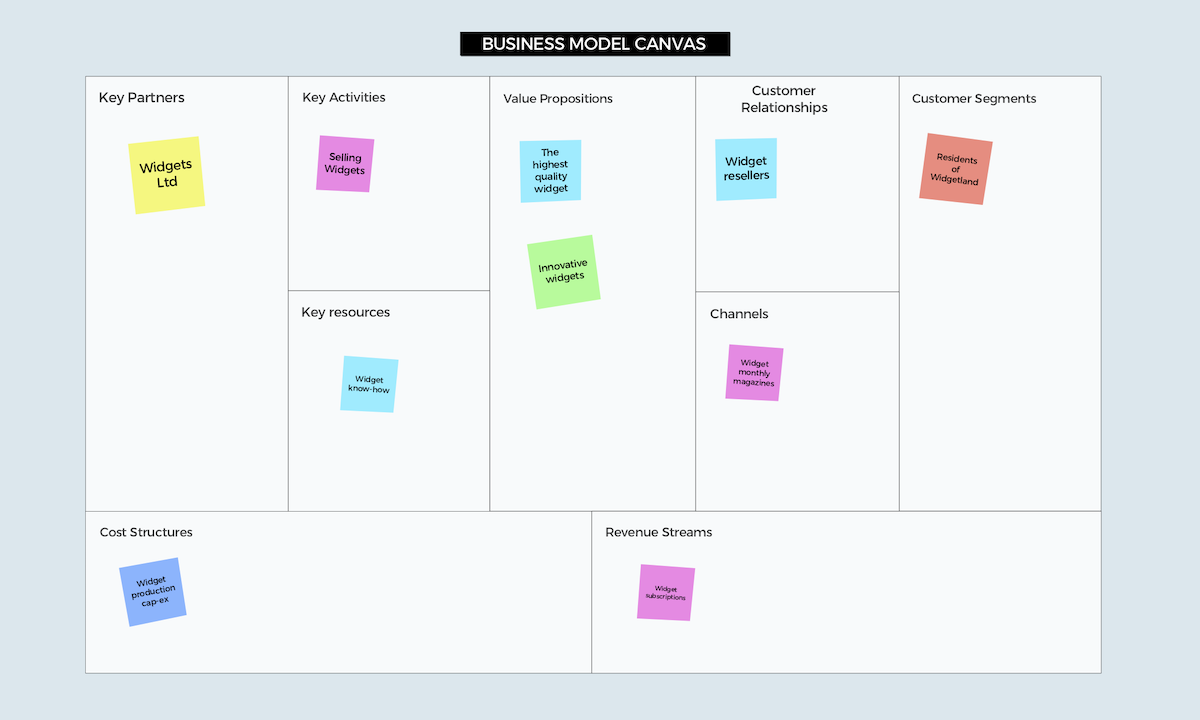Business model generation
book written by Alexander Osterwalder and Yves Pigneur, and published in 2010, introduces the concept of the Business Model Canvas, a strategic management tool that provides a visual framework for developing, describing, and innovating on a business model.
The book has been widely used in business and entrepreneurship education and has influenced the way organizations approach business strategy and development.
The Business Model Canvas consists of nine building blocks, each representing a key aspect of a business:
Customer Segments:
Defines the different groups of people or organizations that the company aims to reach and serve.
Value Propositions:
Describes the unique value the product or service brings to the customers and why they should choose it over competitors.
Channels:
Outlines how a company delivers its value proposition to its customers, whether through direct sales, online channels, partnerships, etc.
Customer Relationships:
Describes the type of relationship a company establishes with its customers, whether it's personal assistance, automated services, etc.
Revenue Streams:
Identifies how the company generates revenue from each customer segment.
Key Resources:
Lists the critical assets and resources required to deliver the value proposition, reach customers, maintain relationships, and earn revenue.
Key Activities:
Describes the most important things a company must do to make its business model work.
Key Partnerships:
Identifies the external organizations, suppliers, or partners that help the business model work.
Cost Structure:
Outlines all the costs associated with operating the business model.
3 biggest lessons:
A shift from Product to Business Model Innovation:
Traditional thinking often revolves around improving products or services. The book challenges this perspective by emphasizing the importance of business model innovation. It encourages businesses to rethink how they create, deliver, and capture value. By focusing on the entire business model, companies can discover new ways to differentiate themselves, create sustainable revenue streams, and adapt to changing market conditions.
Visual Thinking with the Business Model Canvas:
The Business Model Canvas is a central tool introduced in the book, fostering a shift from text-based planning to visual thinking. It provides a one-page visual representation of the entire business model, making it easier for teams to collaborate, communicate, and iterate on their strategies. This visual approach helps break down silos within organizations and promotes a shared understanding of how different elements of the business interact.
Embracing Continuous Innovation and Adaptation:
The book advocates for a mindset of continuous innovation and adaptation. In a dynamic business environment, staying static can be detrimental. The authors encourage businesses to regularly revisit and revise their business models. By doing so, companies can remain agile, respond to emerging opportunities or threats, and proactively shape their industries rather than react to changes. The concept of a "business model prototype" is introduced, urging organizations to experiment and test different elements of their business model before fully implementing them.
ATP:
Kniha ma zaujala hlavne kvôli idey, že je potreba sa pravidelne adaptovať vo svete biznisu nie cez zlepšovanie produktu, ale biznis modelu. Často ľudia vylepšujú produkt, ale nepozerajú nato, že môžu byť úplne v zlom prostredí. Si talentovaný a píšeš články od nuly na svoj blog, ktorý nemá absolutne žiadnu traffic na tvoje blogy. Nepomôže ti ked sa zlepšíš v copy, ale to, že to začneš robiť pre nejaký ustálený brand, budeš im napr. písať maily 2krát týždenne a brať si mesačn retainer zato. Ked budeš šikovný vieš si veľa zarobiť. Pomohlo ti teda to, že si zmenil model a prostredie v ktorom pracuješ a nie to, že si zlepšil produkt.
Je potrebné experimentovať a testovať, čo najviac sadne. Dnes sa všetko hýbe rýchlo a musíš reagovať na každú zmenu. Nemôžeš študovať marketing na vysokej škole ked vieš, že o rok budú zas iné trendy v marketingu. Je dôelžité načasovanie a to , kedy sa so svojou službou/produktom dostaneš na trh.
Keby si predával krypto kurzy a platené skupiny na trading signály v 2021 a zaroven tvoril kontent o tom na tiktok tak by si dnes asi bol na tom fakt dobre. Spravne načasovanie. Správny typ biznis modelu a správne adaptovanie sa nato, čo trh chce. Je oveľa dôležitejšie, aké vozidlo(biznis model) si na svoju cestu vyberieš. Ale s lambom sa dostaneš do cieľa rýchlejšie ako s fiatikom. Preto je dôležité si uvedomiť, že výber a adaptácia správneho biznis modelu sú kľúčové faktory na úspech v podnikaní, neni to vždy iba o tom, aké máš skills.
